Studio and Learning Culture
Our students work hard and long hours in our studios to produce things that help with developing their skills. They are provided with physical resources to build designs, exercises, attend lecture classes, exhibit their work, consult their instructors, and have design juries. The program ensures that studios are clean, comfortable, inspirational, and safe. At the start of all semester, students can choose their own working space in the studio and put their personal touch on the area.
Four studios have a whiteboard, drawing tables, a tracing table, stool chairs, a pinup board, lockers, and an LCD projector. For architectural courses that involve lectures as part of a design task, space equipped with LCD projectors, white and pinup boards, and armchairs are available within the studios. This space is also used for exams, presentations, seminars, and briefings. Between the studios is a long hallway/corridor where models and previously created artwork by students are kept and shown.
Instructors deliver lectures, consult students on their work, and hold juries in the studio. In contrast, students complete their exercises, display their work, and confer with themselves and faculty members. The studios are conveniently close to the faculty and assistant offices. The studio spaces are appropriated to be a learning space that fosters a culture of respect and cooperation between instructors and students and between students. Collaboration and respect are essential for learning and teaching to be successful.
Along with more conventional teaching strategies, we also use unconventional ones, including movie evenings, group discussions, workshops, design computations, excursions, exhibitions, and studio debates. There is a custom whereby staff and students gather to celebrate the end of each semester. These customs enable respectful, engaging, and encouraging interactions between students and professors and harmonize relations.




Figure: Studio learning culture: a. Students celebrating the end of their final jury in 2023, and b, c, & d: students on their final jury in 2023.

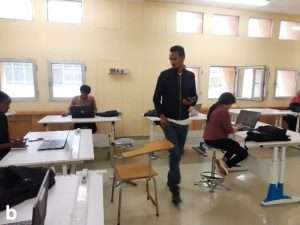
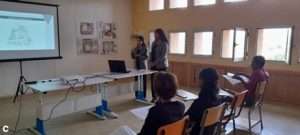
Figure: Faculty & Student interaction in studios: a & b students working in studios with the supervision of faculty, and c. graduating class students presenting their bachelor thesis project in 2023.

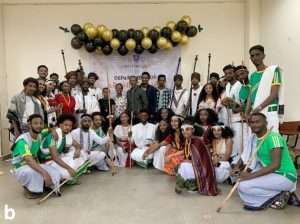

Figure: Graduating class celebration: a, b & c Graduate class 2023 celebrated their last exam wearing traditional clothes representing their diverse origins.
Studio and classroom culture policies
In line with the Jimma University policy, respect for the program’s human and physical resources and the workspace is the basic value of our policies. This comprises keeping the workspace clean and corridors open and caring for oneself-work and others. Our studio culture policy also helps to establish a standard of understanding and respectful relationships between students, Faculty and students, and Faculty and Faculty. Our studio culture policy includes the following seven core points to achieve that.
- Expected from Students
Students are expected to take responsibility for their education and relationship with other students and Faculty. Therefore, it is expected that:
a. Students will prepare for class.
b. Students will attend 85% of their class.
c. Students will appropriately communicate concerns to the faculty.
d. Students will perform assigned tasks on time and to the best of their ability.
- Expected from Faculty
It is the expectation that faculty knowledge and expertise be appropriate for the studio to which they are assigned. Therefore, it is expected that:
a. Faculty will attend class as required.
b. Faculty will communicate their ideas and expectations to the students and should post and hold required office hours.
c. Faculty will consistently portray professional ethics, interpersonal relation, and commitment.
- Faculty and student interaction
The manner of Faculty in the studio does much to set the tone for the studio culture. It is expected that respecting basic interpersonal relationships is fundamental. Therefore, it is likely that:
a. Faculty and students will develop a supportive and collegial atmosphere in the studio.
b. Faculty and students will recognize each other as adults with unique life experiences committed to participating in the best education possible and treat each other as such.
c. Faculty will try at all times to give every student equal attention.
d. Faculty and students will endeavor to get to know each other as individuals and respect each other’s individuality.
e. Faculty and the administration will keep all sections of each given studio in the same space to promote the exchange of ideas and strategies between cells.
- Student-Student interaction
The students’ attitudes in the studio do as much to set the tone for studio culture as the faculty. It is expected that students recognize their peers as individuals worthy of respect. Therefore, it is likely that:
a. Students will implement a student-to-student mentoring program to facilitate communication and support between studio levels.
b. Students will maintain an attitude of mutual respect for one another, each other’s work, their working environment, and how their actions in the studio affect other students’ ability to work.
c. Students will always strive to respect environmental quality.
d. Students will maintain respect for diversity of all kinds.
- Juries
The jury is intended to be a learning environment based on mutual respect between jurors and students. Work is expected to be carefully and thoroughly critiqued, but the critique will be directed to the job, not the student’s character. Therefore, it is likely that:
a. Faculty will ensure that jurors know the studio project adequately before the review begins.
b. Jurors will respect the students and the students’ work and will critique the job, not the person.
c. Juries will be of a reasonable length within the time scheduled.
d. Faculty will provide students with a clear introduction to the structure and desired outcomes of the jury process.
- Promotion and Maintenance of the Studio Culture Policy
The policy is expected to be disseminated and maintained regularly to continuously promote
and support the desired studio culture. Therefore, it is likely that:
a. Student government and the administration will convene regular Studio Culture Committee meetings.
b. There will be multiple opportunities throughout the semester for feedback on compliance with the policy by both Faculty and students.
c. There will be an annual Studio Culture Policy Review.
d. The Studio Culture Policy shall be considered a part of every studio syllabus.
e. Disputes concerning failure to adhere to the Studio Culture Policy will be the charge of the Student Affairs Committee and, if not resolved, should be brought to the attention of either the department chair or the student representative.
Educational trips
The program’s curriculum is designed so that students can have firsthand experience of sites and buildings with architectural values. After students enroll in the History of Ethiopia Architecture class in their 3rd year, the program arranges trips to different places and buildings with architectural value in Ethiopia. During the trip, students stay at governmental universities near the historical site, which allows them to visit and experience other architectural programs in the country. A written report is expected to be submitted to the program when students return to JiT.
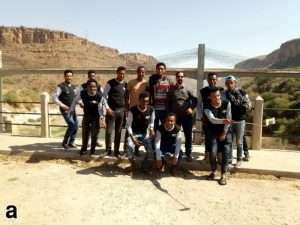
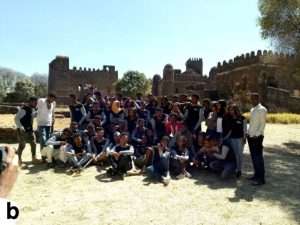
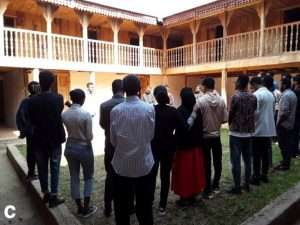

Figure: Educational Trips: Students visiting a. Abay Bridge, Bahirdar, Ethiopia, b. Fasil Ghebbi in Gondar, Ethiopia, c. Aba Jifar Palace in Jimma, Ethiopia, and d. Harar Jugol Wall, in Hara, Ethiopia
Exhibition and Public Speech
Exhibitions are held at the end of every year. Students pin and present what they have been doing for the Institute’s community the year and get feedback from professionals and scholars. In the exhibitions, students get in touch with people with unique perspectives and other experiences, enabling them to communicate with people who do not have background knowledge about architecture. These events allow students to share and showcase their personal artwork collections to the university community and the general public.

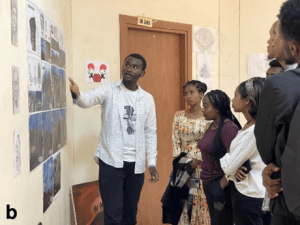
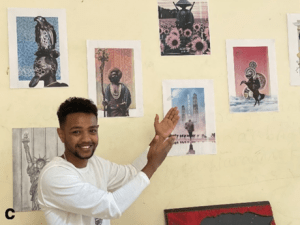

Figure: Student exhibition in JiT in 2021: a. A student looking at other students work, b. A student explaining his work to fresh student interested in joining architecture program, c. A student taking picture with his work, & d. Exhibition organizing team
Faculty-to-faculty interaction
Architecture is a science that works with other applied science fields and follows the principle of art to have comforting and satisfactory undefined and defined spaces for human beings. With this in mind, our program curriculum is designed to engage students and instructors enrolled in our program with other engineering and science programs within our institution and the University at large. Faculties assigned to teach integrated design and architectural science courses are encouraged to collaborate with other engineering program instructors when delivering their systems. The collaboration is not limited to course deliberation but includes interdisciplinary research and community service projects funded by the University. This allows the faculty and students to have an innovative, engaging, and knowledge-sharing learning environment.
Faculty and student interaction
We place a high focus on faculty-student engagement in our program. Students receive information on all faculty contacts on the first day of class. Advisors are assigned to each batch after enrolling in the architecture program’s second year. If necessary, students can get in touch with their trusted advisor, either directly or through their class representative. Students can seek counseling and advice from their class advisers for academic and non-academic issues. The advisor will take care of any student difficulties that can be resolved at that level, and the program coordinator and faculty dean will be notified of any issues that require more oversight.
Other learning opportunities
In addition to traditional classroom learning, our program encourages and facilitates extracurricular events. Through these events, the program creates a positive and productive learning environment for students and Faculty. Among these events are weekend events, including public lectures and discussions, movie nights, debates, workshops, exhibitions, and design computations organized by volunteer students and Faculty every two weeks. The events occur in studios on Saturday afternoons and are open to the entire Jimma University community and the general public.

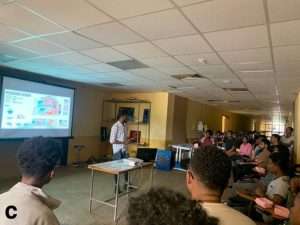

Figure:Non-traditional learning activities: a. Movie Night Poster, b. Students watch documentaries on movie night at their studio, c. 5th-year student presenting his project to junior students, d. Senior students teach junior students how to make portfolios.
Teaching-learning methods
The core philosophy of the teaching-learning process would focus on producing competent, creative, critically minded, and ethical professional designers/builders and good citizens who are intellectually mature, ecologically sensitive, and socially responsible. This aligns with the program’s aim of producing a socially and environmentally conscious professional architect.
The teaching-learning methods adopted to transfer and acquire knowledge and skill development include.
- Design and planning projects backed by classroom lectures, tutorials, and assignments
- Intensive consultations and one-to-one discussions on proposed ideas and design solutions
- Lectures by practicing professionals and resource persons periodically
- Interactive based ―Blended E-Learning and other such self-learning modules,
- Workshop Practice and Laboratory Exercises,
- 3D Model Studies,
- Field visits related to community development/intervention.
- Practical and development-oriented planning and design projects.
- Individual and group seminars/ project work presentations.
- Group tasks/discussions
- Case studies.
Evaluation systems
Every course within the program has different assessment types based on the student performance criteria mapped to the course description. The following are the types of assessments used by instructors to evaluate student performance:
- Examinations
- Jury
- Projects
- Assignments
- Design Tasks
- Presentation
- Written Reports
When evaluating design tasks, instructors will consider not only the course contents and description but also the processes, the final product, the supporting exercises, the student’s method of presenting their project, class participation, and attendance.
Dormitory culture
In JiT, dormitories are arranged based on the respective department’s students; students enrolled in the same program live in the same dormitories. This enables architecture students to collaborate on tasks and share ideas. Students’ interaction at different levels creates peer-to-peer learning and social cohesiveness. The program supports dormitory students by providing drawing instruments that can be taken to the dormitory for work. The program is also working towards encouraging senior students to engage junior students with formal mentoring programs.
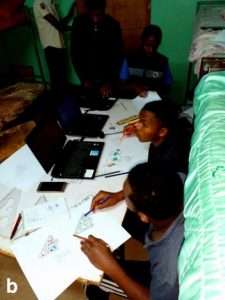

Figure: Dormitory study culture, a. peer tutoring, and b. student collaboration .
Architecture and Urban Planning |
